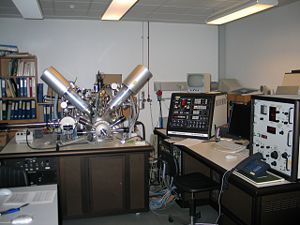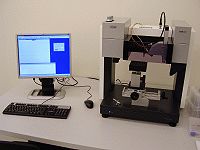Specific Process Knowledge/Characterization/SIMS: Secondary Ion Mass Spectrometry: Difference between revisions
Appearance
No edit summary |
No edit summary |
||
| Line 4: | Line 4: | ||
==Atomika SIMS== | ==Atomika SIMS== | ||
[[Image:Equipment_SIMS.jpg|300x300px|thumb|Atomika SIMS: positioned in the basement of building 346 (underneath the cleanroom).]] | [[Image:Equipment_SIMS.jpg|300x300px|thumb|Atomika SIMS: positioned in the basement of building 346 (underneath the cleanroom).]] | ||
'''Feedback to this page''': '''[mailto:labadviser@danchip.dtu.dk?Subject=Feed%20back%20from%20page%20http://labadviser.danchip.dtu.dk/index.php/Specific_Process_Knowledge/Characterization/Drop_Shape_Analyzer click here]''' | |||
== The Drop Shape Analyzer == | |||
[[image:DropShapeAnalyzer.jpg|200x200px|right|thumb|The Krüss DSA 100s Drop Shape Analyzer]] | |||
The Krüss DSA 100S Drop Shape Analyzer will analyze the shape a drop of liquid on a surface, or suspended from a needle, in order to calculate the contact angle, or the surface tension, respectively. It is mostly used to determine the contact angle of water as a measure of the hydrophobicity/hydrophility of the sample surface. | |||
'''The user manual, user APV(s), technical information, and contact information can be found in LabManager:''' | |||
[http://labmanager.danchip.dtu.dk/function.php?module=Machine&view=view&mach=240 Drop Shape Analyzer in LabManager] | |||
==An overview of the performance of the Drop Shape Analyzer== | |||
{| border="2" cellspacing="0" cellpadding="10" | |||
|- | |||
!style="background:silver; color:black;" align="left"|Purpose | |||
|style="background:LightGrey; color:black"|Imaging and analysis of of the shape of the interface between liquid and air||style="background:WhiteSmoke; color:black"| | |||
*Measurement of contact angle between sample surface and liquid | |||
*Measurement of surface tension of liquid | |||
|- | |||
!style="background:silver; color:black" align="left"|Performance | |||
|style="background:LightGrey; color:black"|Measurement accuracy | |||
|style="background:WhiteSmoke; color:black"| | |||
*Highly dependent on analysis conditions (image quality and fitting model); usually around ±0.5°. Using several measurement points is recommended. | |||
|- | |||
!style="background:silver; color:black" align="left"|Process parameters | |||
|style="background:LightGrey; color:black"|Available liquids | |||
|style="background:WhiteSmoke; color:black"| | |||
*Syringe 1: Water (H2O) | |||
*Syringe 2: Diiodo-methane (I2CH2) | |||
*Syringe 3: Benzyl alcohol (C6H5CH2OH) | |||
*Syringe 4: Available | |||
*Manual dispense is also possible | |||
|- | |||
!style="background:silver; color:black" align="left"|Sample requirements | |||
|style="background:LightGrey; color:black"|Substrate material allowed | |||
|style="background:WhiteSmoke; color:black"| | |||
*In principle all materials | |||
|- | |||
|style="background:silver; color:black"| | |||
|style="background:LightGrey; color:black"|Substrate size | |||
|style="background:WhiteSmoke; color:black"| | |||
*Up to 6" wafers. In order to measure, a few square mm's of flat surface is required. | |||
|- | |||
|style="background:silver; color:black"| | |||
|style="background:LightGrey; color:black"|Batch size | |||
|style="background:WhiteSmoke; color:black"| | |||
*One sample at a time | |||
|- | |||
|} | |||
Revision as of 13:00, 24 January 2014
Feedback to this page: click here
Atomika SIMS

Feedback to this page: click here
The Drop Shape Analyzer

The Krüss DSA 100S Drop Shape Analyzer will analyze the shape a drop of liquid on a surface, or suspended from a needle, in order to calculate the contact angle, or the surface tension, respectively. It is mostly used to determine the contact angle of water as a measure of the hydrophobicity/hydrophility of the sample surface.
The user manual, user APV(s), technical information, and contact information can be found in LabManager:
Drop Shape Analyzer in LabManager
An overview of the performance of the Drop Shape Analyzer
| Purpose | Imaging and analysis of of the shape of the interface between liquid and air |
|
|---|---|---|
| Performance | Measurement accuracy |
|
| Process parameters | Available liquids |
|
| Sample requirements | Substrate material allowed |
|
| Substrate size |
| |
| Batch size |
|
